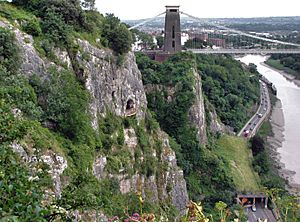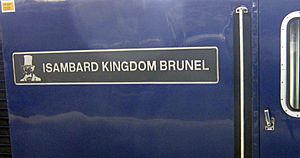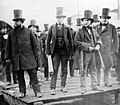Isambard Kingdom Brunel facts for kids
Quick facts for kids
Isambard Kingdom Brunel
|
|
|---|---|

|
|
| Born | 9 April 1806 Portsmouth, England
|
| Died | 15 September 1859 (aged 53) Westminster, London, England
|
| Nationality | British |
| Education |
|
| Occupation | Engineer |
| Spouse(s) | Mary Elizabeth Horsley |
| Children |
|
| Parent(s) |
|
| Engineering career | |
| Discipline | |
| Institutions | Institution of Civil Engineers |
| Projects | |
| Significant design | Royal Albert Bridge |
| Signature | |
 |
|
Isambard Kingdom Brunel (15 September 1859), was an English mechanical and civil engineer who is considered "one of the most ingenious and prolific figures in engineering history", "one of the 19th century engineering giants", and "one of the greatest figures of the Industrial Revolution, [who] changed the face of the English landscape with his groundbreaking designs and ingenious constructions". Brunel built dockyards, the Great Western Railway, a series of steamships including the first propeller-driven transatlantic steamship, and numerous important bridges and tunnels. His designs revolutionised public transport and modern engineering.
Though Brunel's projects were not always successful, they often contained innovative solutions to long-standing engineering problems. During his career, Brunel achieved many engineering firsts, including assisting in the building of the first tunnel under a navigable river and development of SS Great Britain, the first propeller-driven, ocean-going, iron ship, which, when built in 1843, was the largest ship ever built.
Brunel set the standard for a well-built railway, using careful surveys to minimise gradients and curves. This necessitated expensive construction techniques, new bridges, new viaducts, and the two-mile-long Box Tunnel. One controversial feature was the wide gauge, a "broad gauge" of 7 ft 1⁄4 in (2,140 mm), instead of what was later to be known as "standard gauge" of 4 ft 8 1⁄2 in (1,435 mm).
Brunel astonished Britain by proposing to extend the Great Western Railway westward to North America by building steam-powered, iron-hulled ships. He designed and built three ships that revolutionised naval engineering: the SS Great Western (1838), the SS Great Britain (1843), and the SS Great Eastern (1859).
In 2002, Brunel was placed second in a BBC public poll to determine the "100 Greatest Britons". In 2006, the bicentenary of his birth, a major programme of events celebrated his life and work under the name Brunel 200.
Contents
Personal life
In 1830, he was elected a Fellow of the Royal Society.
On 5 July 1836, Brunel married Mary Elizabeth Horsley (b. 1813), who came from an accomplished musical and artistic family, being the eldest daughter of composer and organist William Horsley. They established a home at Duke Street, Westminster, in London.
In 1843, while performing a conjuring trick for the amusement of his children, Brunel accidentally inhaled a half-sovereign coin, which became lodged in his windpipe. A special pair of forceps failed to remove it, as did a machine devised by Brunel to shake it loose. At the suggestion of his father, Brunel was strapped to a board and turned upside-down, and the coin was jerked free. He recuperated at Teignmouth, and enjoyed the area so much that he purchased an estate at Watcombe in Torquay, Devon. Here he commissioned William Burn to design Brunel Manor and its gardens to be his country home. He never saw the house or gardens finished, as he died before it was completed.
Brunel, a heavy smoker, who had been diagnosed with Bright's disease (nephritis), suffered a stroke in September 1859, just before the Great Eastern made her first voyage to New York. He died ten days later at the age of 53 and was buried, like his father, in Kensal Green Cemetery in London. The grave is insignificant by the standards of the cemetery and easily missed. It lies south of the main central path, midway between the entrance and the central chapel, around 20m from the path and screened by trees.
He left behind his wife Mary and three children: Isambard Brunel Junior (1837–1902), Henry Marc Brunel (1842–1903) and Florence Mary Brunel (1847–1876). Henry Marc followed his father and grandfather in becoming a successful civil engineer.
Legacy
A celebrated engineer in his era, Brunel remains revered today, as evidenced by numerous monuments to him. There are statues in London at Temple (pictured), Brunel University and Paddington station, and in Bristol, Plymouth, Swindon, Milford Haven and Saltash. A statue in Neyland in Pembrokeshire in Wales was stolen in August 2010. The topmast of the Great Eastern is used as a flagpole at the entrance to Anfield, Liverpool Football Club's ground. Contemporary locations bear Brunel's name, such as Brunel University in London, shopping centres in Swindon and also Bletchley, Milton Keynes, and a collection of streets in Exeter: Isambard Terrace, Kingdom Mews, and Brunel Close. A road, car park, and school in his home city of Portsmouth are also named in his honour, along with one of the city's largest public houses. There is an engineering lab building at the University of Plymouth named in his honour.
In a 2002 public television poll conducted by the BBC to select the 100 Greatest Britons, Brunel was placed second, behind Winston Churchill. Brunel's life and works have been depicted in numerous books, films and television programs. The 2003 book and BBC TV series Seven Wonders of the Industrial World included a dramatisation of the building of the Great Eastern.
Many of Brunel's bridges are still in use. Brunel's first engineering project, the Thames Tunnel, is now part of the London Overground network. The Brunel Engine House at Rotherhithe, which once housed the steam engines that powered the tunnel pumps, now houses the Brunel Museum dedicated to the work and lives of Henry Marc and Isambard Kingdom Brunel. Many of Brunel's original papers and designs are now held in the Brunel Institute alongside the SS Great Britain in Bristol, and are freely available for researchers and visitors.
Brunel is credited with turning the town of Swindon into one of the fastest growing towns in Europe during the 19th century. Brunel's choice to locate the Great Western Railway locomotive sheds there caused a need for housing for the workers, which in turn gave Brunel the impetus to build hospitals, churches and housing estates in what is known today as the 'Railway Village'. According to some sources, Brunel's addition of a Mechanics Institute for recreation and hospitals and clinics for his workers gave Aneurin Bevan the basis for the creation of the National Health Service.
GWR Castle Class steam locomotive no. 5069 was named Isambard Kingdom Brunel, after the engineer; and BR Western Region class 47 diesel locomotive no. D1662 (later 47484) was also named Isambard Kingdom Brunel. GWR's successor Great Western Railway has named both its old InterCity 125 power car 43003 and new InterCity Electric Train 800004 as Isambard Kingdom Brunel.
In 2006 the Royal Mint struck two £2 coins to "celebrate the 200th anniversary of Isambard Kingdom Brunel and his achievements". The first depicts Brunel with a section of the Royal Albert Bridge and the second shows the roof of Paddington Station. The Post Office issued a set of commemorative stamps.
For the 100th anniversary of the Royal Albert Bridge, the words "I.K. BRUNEL ENGINEER 1859" were engraved on either end to commemorate his enduring legacy. The words had become obscured by paint, but were restored by Network Rail and revealed again in 2006.
Brunel was the subject of Great, a 1975 animated film directed by Bob Godfrey. It won the Academy Award for Animated Short Film at the 48th Academy Awards in March 1976.
The song "The Underfall Yard" on progressive rock band Big Big Train's 2009 album of the same name is a homage to several great English engineers, including Brunel, who worked on the Underfall Yard itself in the 1830s.
At the 2012 Summer Olympics opening ceremony, Brunel was portrayed by Kenneth Branagh in a segment showing the Industrial Revolution.
The steampunk musical group The Men That Will Not Be Blamed for Nothing performed a song called Brunel on their album This May Be The Reason Why The Men That Will Not Be Blamed For Nothing Cannot Be Killed By Conventional Weapons, released in 2012. The song makes reference to Brunel's achievements as an engineer.
The 2013 album The Last Ship by Sting includes the song "Ballad of the Great Eastern".
Images for kids
-
The Thames Tunnel in 2005
-
The Clifton Suspension Bridge spans Avon Gorge, linking Clifton in Bristol to Leigh Woods in North Somerset
-
The Royal Albert Bridge spanning the river Tamar at Saltash
-
Paddington station, still a mainline station, was the London terminus of the Great Western Railway
-
A reconstruction of Brunel's atmospheric railway, using a segment of the original piping at Didcot Railway Centre
-
A section of the actual pipe in the Swindon Steam Railway Museum
-
Maiden voyage of the Great Western in April 1838
-
Launch of the Great Britain in 1843
-
Great Eastern shortly before launch in 1858
-
Brunel at the launch of the Great Eastern with John Scott Russell and Lord Derby
See also
 In Spanish: Isambard Kingdom Brunel para niños
In Spanish: Isambard Kingdom Brunel para niños



















